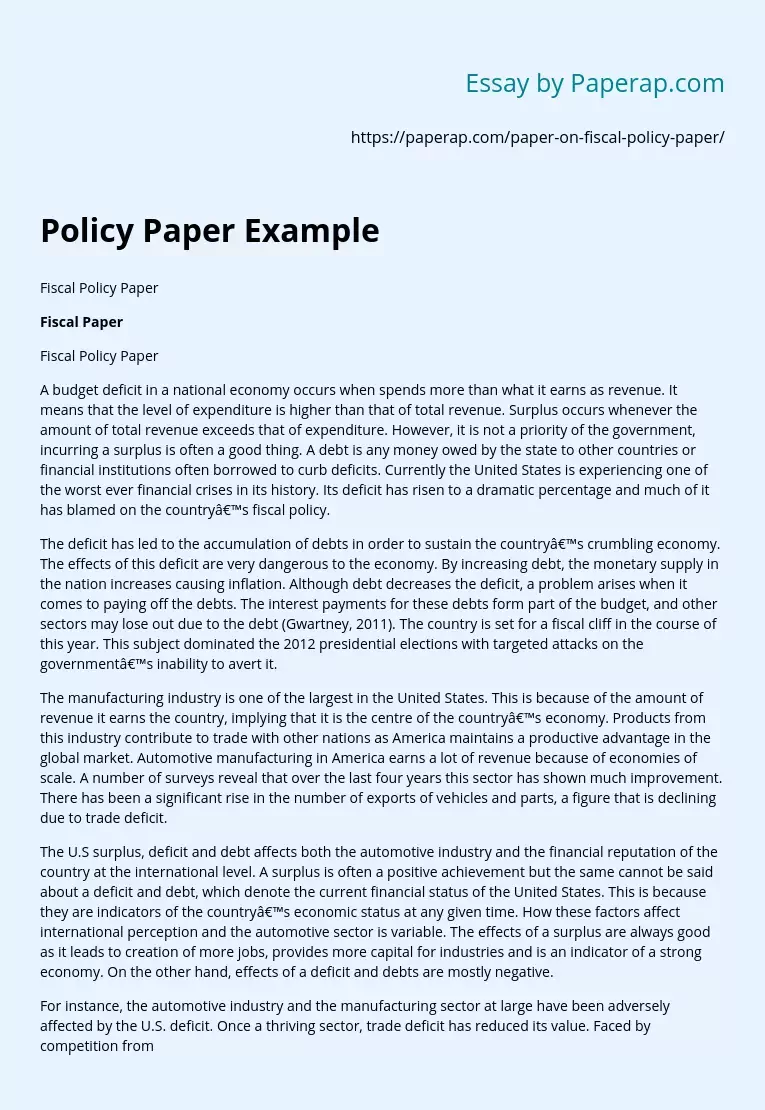Policy Paper Example
Fiscal Policy Paper
Fiscal Paper
Fiscal Policy Paper
A budget deficit in a national economy occurs when spends more than what it earns as revenue. It means that the level of expenditure is higher than that of total revenue. Surplus occurs whenever the amount of total revenue exceeds that of expenditure. However, it is not a priority of the government, incurring a surplus is often a good thing. A debt is any money owed by the state to other countries or financial institutions often borrowed to curb deficits.
Currently the United States is experiencing one of the worst ever financial crises in its history. Its deficit has risen to a dramatic percentage and much of it has blamed on the country’s fiscal policy.
The deficit has led to the accumulation of debts in order to sustain the country’s crumbling economy. The effects of this deficit are very dangerous to the economy. By increasing debt, the monetary supply in the nation increases causing inflation.
Although debt decreases the deficit, a problem arises when it comes to paying off the debts. The interest payments for these debts form part of the budget, and other sectors may lose out due to the debt (Gwartney, 2011). The country is set for a fiscal cliff in the course of this year. This subject dominated the 2012 presidential elections with targeted attacks on the government’s inability to avert it.
The manufacturing industry is one of the largest in the United States. This is because of the amount of revenue it earns the country, implying that it is the centre of the country’s economy.
Products from this industry contribute to trade with other nations as America maintains a productive advantage in the global market. Automotive manufacturing in America earns a lot of revenue because of economies of scale. A number of surveys reveal that over the last four years this sector has shown much improvement. There has been a significant rise in the number of exports of vehicles and parts, a figure that is declining due to trade deficit.
The U.S surplus, deficit and debt affects both the automotive industry and the financial reputation of the country at the international level. A surplus is often a positive achievement but the same cannot be said about a deficit and debt, which denote the current financial status of the United States. This is because they are indicators of the country’s economic status at any given time. How these factors affect international perception and the automotive sector is variable. The effects of a surplus are always good as it leads to creation of more jobs, provides more capital for industries and is an indicator of a strong economy. On the other hand, effects of a deficit and debts are mostly negative.
For instance, the automotive industry and the manufacturing sector at large have been adversely affected by the U.S. deficit. Once a thriving sector, trade deficit has reduced its value. Faced by competition from other countries such as Germany and China, the auto industry, once mainly an exporter has started to import vehicles and parts. This has also contributed to the country’s overall deficit. This loss of competitiveness is what drives America to outsource. For as long as America keeps incurring debt to pay its deficit, less money is channeled into reviving the automotive industry. People are affected by losing their jobs and earning less income. In the end, the cost of living rises.
Internationally, the U.S is almost losing its status among the superpowers. Though it remains a dominant player in international politics, it has faced constant criticism for its failure to maintain a stable financial position. All these show how the above-mentioned factors affect international view of America and its economy, particularly in the manufacturing sector. This means that they play a great role in America’s economy and help shape perception of the country’s financial position.
Policy Paper Example. (2019, Dec 05). Retrieved from https://paperap.com/paper-on-fiscal-policy-paper/

